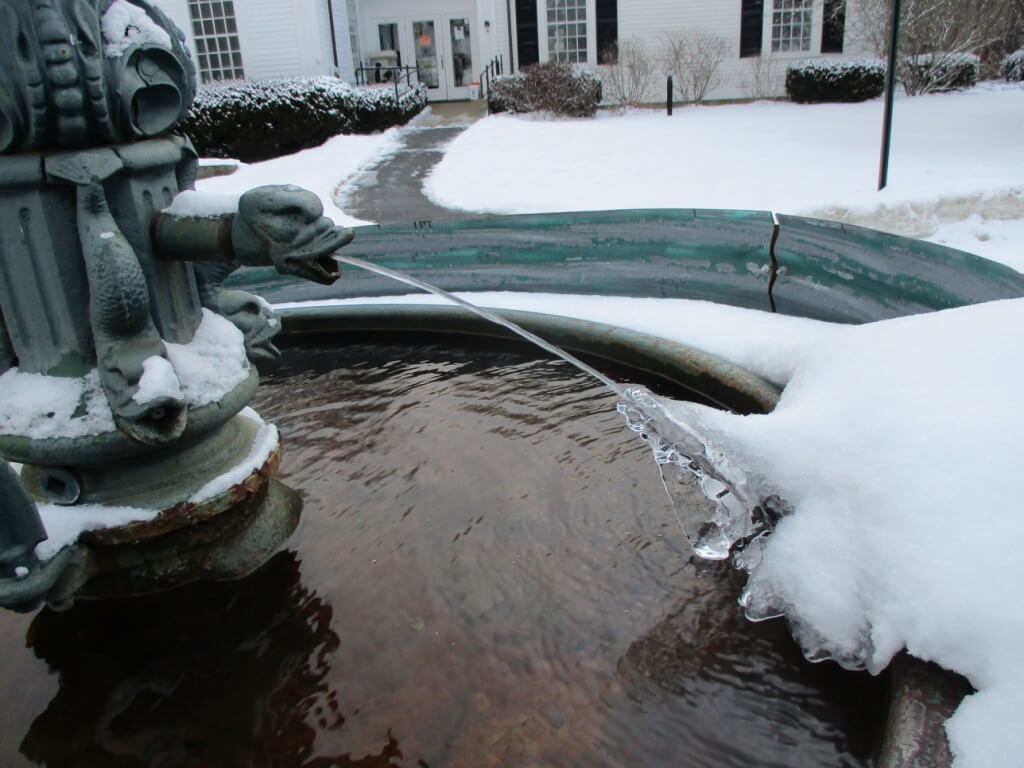Being a somewhat random collection of discoveries large and small…
These images of ice sculptures forming on the town fountain outside the library were snapped daily over a period of several weeks in February of 2019 by Ivan Ussach, library director.

Did you know?: Total solar eclipses, like the recent one on 4-8-24, are unique to our solar system, and possibly the cosmos: they result from the incredibly unlikely combination of the sun being both 400 times larger than the moon and 400 times further away from Earth–thus allowing for a “perfect fit.”
Did you know?: In 1863, Jules Verne (Journey to the Center of the Earth, Around the World in 80 Days) wrote Paris in the 20th Century, a manuscript that predicted glass skyscrapers, submarines, the technology to land on the moon and feminism. His publisher rejected the story because it was so unbelievable, so Verne put it in a safe–where it was forgotten until his great-grandson rediscovered it in 1989. It was published in 1994. (Verne has been the second most-translated author in the world since 1979, ranking below Agatha Christie and above William Shakespeare.)

The hottest new thing!: Gone are the days when you needed to find 27 different books to find out about 27 different things. Now, get this, people have invented something called an encyclopedia: en-cy-clo-pe-di-a. And, even better—it’s in color! Why sit staring at your phone when you can come peruse all 22 volumes of the 2022 World Book Encyclopedia!
Did you know?: Our sun travels about 1 million miles a day as it revolves around the galactic center. How many earth years does it take the sun to complete one orbit or revolution around the Milky Way: 2 million years? 20 million years? 200 million years? One solar birthday is equal to 200 million earth years. So at 4.6 billion earth years old, Sol, our sun, is about 23 solar years old.
Did you know?: Each year our galaxy, The Milky Way, gives birth to about 10 new stars. (From Magnificent Universe by Ken Croswell.)
First library in America: from the Nov. 8th Writer’s Almanac: On this day in 1731, a group of young men in Philadelphia pooled their money to set up the first library in America. The idea for a library came about when Benjamin Franklin started a club with about 50 friends so they could debate about politics, morality, and the natural sciences. The group was called the Club of Mutual Improvement. When they disagreed about a topic, they liked to consult books. But books were expensive in those days, so they combined their resources to found a subscription library. They called it the Philadelphia Library Company. The rule was that any “civil gentleman” could browse through the volumes, but only subscribers were allowed to borrow them. The library expanded over the years. Later it moved to Carpenter’s Hall, the building where the First Continental Congress met in 1774. Franklin said that after the library opened, “reading became fashionable, and our people, having no public amusements to divert their attention from study, became better acquainted with books.”
Still circulating after all these years: It was an exciting moment recently when Library volunteer Freddie Fellows pulled our 1850 edition of The Scarlet Letter, Nathaniel Hawthorne’s classic, for a patron at another library. Set in the Massachusetts Bay Colony during the 1640s, the book was one of the first mass-produced books in the United States. What a thrill to see such an old book still circulating today! (It has no commercial value in the used book market due to its library markings.)
Darwin on Worms: From the Oct. 11 Writer’s Almanac: On this day Charles Darwin published The Formation of Vegetable Mould Through the Action of Worms on this date in 1881. It was his last scientific book, and his most successful. In it, he explains that the very ground we walk upon has passed through the bodies of worms and emerged as castings. He also estimated that there are more than 53,000 worms at work in any given acre of land, and reported that they had turned a rocky field behind his uncle’s house into smooth soil over the course of many years. He was fascinated by the work of the earthworm, which he called an “unsung creature which, in its untold millions, transformed the land as the coral polyps did the tropical sea.” On the surface, the study of earthworms seems to have little to do with the work on evolution and natural selection that made him famous. But this book, too, was about the inexorable processes of nature that, over long spans of time, can bring about dramatic changes.
For Parents and Educators: Two new educational resource books have been added to the collection: The Enchanted Hour: The Miraculous Power of Reading Aloud in the Age of Abstraction, by Meghan Cox Gurdon; and Middle School Matters: The 10 Skills Kids Need to Thrive in Middle School and Beyond – How Parents Can Help, by Phyllis Fogell. Several top fiction CD audio books and a slew of excellent non-fiction books have also been added to the Children’s Section, courtesy of educator extraordinaire Brian Snell.
Almost Astronauts: 13 Women Who Dared to Dream: A new addition to the collection, this 2009 award winning childrens book (ages 10 and up) chronicles the quixotic efforts of 13 women to win admission into NASA’s initial astronaut training program in the early 1960s. The women were all pilots (one, Jerrie Cobb, had more hours in the air than John Glenn or Scott Carpenter), earned high scores in preliminary tests, and even counted a senator’s wife among their number. But resistance came from all directions. Properly noting, however, that losing “depends on where you draw the finish line,” the book closes with chapters on how women did ultimately win their way into space.
100th Anniversary: 2019 marked the 100th Anniversary of the Warwick Free Public Library in its current building. It was gifted by the Baptist Church, which had experienced a serious decline in enrollment, and the Library moved across the street from Town Hall, where it had been housed in the present-day Assessors Office since that building’s construction in 1894.
Cycle of Mysteries: A visitor from Worcester returned an old copy of The Door by Mary Rhinehart. Its age drew my attention, which led the traveler to remark that he’d wanted to take a drive, and he told me and another Warwickian that he’d become curious about Rhinehart after her name appeared as a Jeopardy! clue in connection with the phrase “The butler did it.” He said she was the American equivalent of Agatha Christie – before Agatha Christie. The Warwickian, being a mystery fan, decided to take it out on the spot. And, as she was leaving, another patron walked in to return Christie’s Easy to Kill. Cycle complete!
Re-wild childhood: A generous donor gifted the Library with a copy of Lost Words, an artistic rendering of 20 common nature words among the 40 dropped from a recent edition of the Oxford Junior Dictionary. The lost words include such familiars as acorn, dandelion, fern, heron and newt. Their replacements include such more modern familiars as blog, broadband, bullet-point and voicemail. This self-described “spell-book” has, the publishers, say, “begun a grassroots movement to re-wild childhood across Britain, Europe and North America”.
Electric cars – Been there, done that?: A striking book of colorized historical photographs called The Paper Time Machine was on display when I began, and the time came to switch it out with one of the many other impressive large format art-related documentary volumes from the shelf below. Before shelving it I opened it at random to a photo, c. 1912, titled “A young woman uses a hand-cranked battery charger to power her electric Columbia Mark 68 Victoria automobile.” The accompanying text notes: “At the beginning of the 1910s, around 38 percent of all cars in America were electric.” I decided to take it home and found it needed to be catalogued. When I tried to catalog it I learned it was the only copy of the book in all of Central and Western Mass! (The following page contained a photo of the massive iceberg thought to have sunk The Titanic.)
























